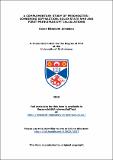Files in this item
A complementary study of perovskites : combining diffraction, solid-state NMR and first principles DFT calculations
Item metadata
| dc.contributor.advisor | Lightfoot, Philip | |
| dc.contributor.advisor | Ashbrook, Sharon E. | |
| dc.contributor.author | Johnston, Karen Elizabeth | |
| dc.coverage.spatial | xvi, 412 | en_US |
| dc.date.accessioned | 2011-04-21T14:40:33Z | |
| dc.date.available | 2011-04-21T14:40:33Z | |
| dc.date.issued | 2010 | |
| dc.identifier | uk.bl.ethos.552529 | |
| dc.identifier.uri | https://hdl.handle.net/10023/1837 | |
| dc.description.abstract | Perovskites, ABX₃, and their associated solid-solutions are a particularly important and attractive area of research within materials chemistry. Owing to their structural and compositional flexibility and potential physical properties they are one of the largest classes of materials currently under investigation. This thesis is concerned with the synthesis and structural characterisation of several perovskite-based materials using a combined approach of high-resolution synchrotron X-ray and neutron powder diffraction (NPD), solid-state Nuclear Magnetic Resonance (NMR) and first-principles Density Functional Theory (DFT) calculations. Initial investigations concentrated on room temperature NaNbO₃, a perovskite widely debated in the literatue. Published crystallographic data indicate NaNbO₃ possesses two crystallographically distinct Na sites in space group Pbcm. Whilst some of our materials appear in agreement with this (notably a commercially purchased sample) many of our laboratory-synthesised samples of NaNbO₃ routinely comprise of two phases, which we show to be the antiferroelectric Pbcm and polar P2₁ma polymorphs. Several different synthetic methods were utilised during this investigation and the quantity of each phase present was found to vary as a function of preparative method. ²³Na, ⁹³Nb and ¹⁷O DFT calculations were used in conjunction with experiment to aid in spectral analysis, assignment and interpretation. In addition, ab initio random structure searching (AIRSS) was utilised in an attempt to predict the most stable phases of NaNbO₃. This proved to be both successful and highly informative. A series of NaNbO₃-related solid-solutions, namely K[subscript(x)]Na[subscript(1-x)]NbO₃ (KNN), Li[subscript(x)]Na[subscript(1-x)]NbO₃ (LNN) and Na[subscript(1-x)]Sr[subscript(x/2)]□[subscript(x/2)]NbO₃ (SNN) have also been synthesised and characterised. The substitution of K⁺ , Li⁺ and Sr²⁺ cations onto the A site appears to produce the same polar P2₁ma phase initially identified in the room temperature NaNbO₃ investigation. The abrupt change in cation size in the KNN and LNN series, and the introduction of vacancies in the SNN series, is thought to result in a structural distortion which, in turn, causes the formation of the P2₁ma phase. A low temperature synchrotron X-ray powder diffraction study (12 < T < 295 K) was completed for a sample of NaNbO₁ composed of the P2₁ma polymorph (~90%) and a small quantity of the Pbcm phase (~10%). A region of phase coexistence was identified between the P2₁ma, R3c and Pbcm phases over a relatively large temperature range. Full conversion of the P2₁ma phase to the low temperature R3c phase was not possible and, consistently, the P2₁ma phase was the most abundant phase present. Factors such as structural, strain, crystallite size and morphology are thought to be crucial in determining the exact phases of NaNbO₃ produced, both at low and room temperature. The solid-solution La[subscript(1-x)]Y[subscript(x)]ScO₃ was also investigated. Compositions x = 0, 0.2, 0.4, 0.6, 0.8 and 1 were successfully synthesised and characterised. Refined high-resolution NPD data indicates that an orthorhombic structure, in space group Pbnm, was retained throughout the solid-solution. Using ⁴⁵Sc and ⁸⁹Y MAS NMR each sample was found to exhibit disorder, believed to result from both a distribution of quadrupole and chemical shifts. NMR parameters were calculated for several model Sc and Y compounds using DFT methods to determine the feasibility and accuracy of ⁴⁵Sc and ⁸⁹Y DFT calculations. These proved successful and subsequent calculations were completed for the end members LaScO₃ and YScO₃. DFT calculations were also utilised to gain insight into the disorder exhibited in the La[subscript(1-x)]Y[subscript(x)]ScO₃ solid-solution. | en_US |
| dc.language.iso | en | en_US |
| dc.publisher | University of St Andrews | |
| dc.subject.lcc | QD181.O1J7 | en_US |
| dc.subject.lcsh | Oxides--Synthesis | en_US |
| dc.subject.lcsh | Oxides--Analysis | en_US |
| dc.subject.lcsh | Neutrons--Diffraction | en_US |
| dc.subject.lcsh | Magnetic resonance imaging | en_US |
| dc.subject.lcsh | Density functionals | en_US |
| dc.subject.lcsh | Perovskite | en_US |
| dc.title | A complementary study of perovskites : combining diffraction, solid-state NMR and first principles DFT calculations | en_US |
| dc.type | Thesis | en_US |
| dc.type.qualificationlevel | Doctoral | en_US |
| dc.type.qualificationname | PhD Doctor of Philosophy | en_US |
| dc.publisher.institution | The University of St Andrews | en_US |
This item appears in the following Collection(s)
Items in the St Andrews Research Repository are protected by copyright, with all rights reserved, unless otherwise indicated.

